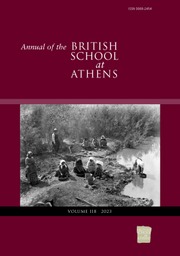No CrossRef data available.
Article contents
THE ‘SWORD BEARERS’: WOMEN BEARING SWORDS? RETHINKING A GROUP OF FIGURES IN MYCENAEAN PICTORIAL VASE PAINTING
Published online by Cambridge University Press: 28 October 2024
Abstract
This paper focuses on a particular group of human figures attested on a number of Late Helladic (LH) IIIA2–B1 pictorial kraters which show specific attributes: they have long hair, wear an elaborate cloak-like robe and bear a sword on their chest. Furthermore, they appear in clearly peaceful representations like chariot or processional scenes. These accurately rendered ‘Sword Bearers’ have so far been assumed to be of male sex due to the presence of the sword; the interpretation proposed here, that they are women, is based on the presence of distinctive female traits as also found on female representations on pictorial vessels and other media of the same period. Particularly striking is the similarity with the enigmatic ‘Sword Bearer’ from the Cult Centre of Mycenae, who is the sole contemporary model of a female figure with a sword wrapped in a long cloak. Though not postulating that these figures are female warriors, attention will be drawn to the fact that weapons have a strong association to the female imagery as well to the sphere of ritual – a sphere in which women played, as is well known, a predominant role in Aegean culture.
Το παρόν άρθρο επικεντρώνεται στη μελέτη και παρουσίαση μίας συγκεκριμένης ομάδας μορφών που εντοπίζονται σε έναν περιορισμένο αριθμό κρατήρων της Υστεροελλαδικής (YE) ΙΙΙΑ2–Β1 περιόδου. Οι εν λόγω μορφές παρουσιάζουν κάποια ιδιαίτερα χαρακτηριστικά: έχουν μακριά κόμη, επιμελημένη ενδυμασία και φέρουν ξίφος στο ύψος του στήθους τους. Επιπλέον, εμφανίζονται σε παραστάσεις που αποδεδειγμένα έχουν ειρηνικό περιεχόμενο, όπως σκηνές με άρματα ή πομπές. Η έρευνα θεωρούσε έως τώρα ότι οι «Ξιφοφόροι» ήταν άνδρες λόγω της παρουσίας των ξιφών. Η ερμηνεία που προτείνεται εδώ είναι ότι πιθανόν πρόκειται για γυναίκες και θεμελιώνεται επάνω στο επιχείρημα ότι τα διακριτά χαρακτηριστικά τους απαντούν σε παραστάσεις γυναικείων μορφών σε αγγεία καθώς και σε άλλα μέσα της ίδιας περιόδου. Ιδιαίτερα εντυπωσιάζει η ομοιότητά τους με την πιο αινιγματική «Ξιφοφόρο» στο θρησκευτικό κέντρο των Μυκηνών, η οποία αποτελεί και το μοναδικό σύγχρονο μοντέλο γυναικείας μορφής με ξίφος. Αν και δεν υποστηρίζεται στην παρούσα μελέτη ότι οι μορφές αυτές είναι γυναίκες πολεμίστριες, θα πρέπει, ωστόσο, να επισημανθεί ότι τα όπλα έχουν μία ισχυρή σύνδεση με τη γυναικεία εικονογραφία καθώς και με τη σφαίρα των τελετουργιών, στις οποίες οι γυναίκες έπαιζαν, ως γνωστόν, κυρίαρχο ρόλο στον πολιτισμό του Αιγαίου.
Μετάφραση: Ε. Καλογερούδη
- Type
- Articles
- Information
- Copyright
- Copyright © The Author(s), 2024. Published by Cambridge University Press on behalf of The Council, British School at Athens
Footnotes
To Gerhard Hiesel, archaeologist, a deeply good man and a good cook.


